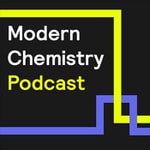Modern Chemistry Podcast – Details, episodes & analysis
Podcast details
Technical and general information from the podcast's RSS feed.

Modern Chemistry Podcast
Paul Orange Ph.D.
Frequency: 1 episode/63d. Total Eps: 20

Recent rankings
Latest chart positions across Apple Podcasts and Spotify rankings.
Apple Podcasts
🇩🇪 Germany - chemistry
02/08/2025#54🇺🇸 USA - chemistry
02/08/2025#28🇩🇪 Germany - chemistry
01/08/2025#51🇺🇸 USA - chemistry
01/08/2025#19🇩🇪 Germany - chemistry
31/07/2025#49🇺🇸 USA - chemistry
31/07/2025#31🇩🇪 Germany - chemistry
30/07/2025#48🇺🇸 USA - chemistry
30/07/2025#29🇩🇪 Germany - chemistry
29/07/2025#47🇺🇸 USA - chemistry
29/07/2025#25
Spotify
No recent rankings available
Shared links between episodes and podcasts
Links found in episode descriptions and other podcasts that share them.
See all- https://incompetech.com
9228 shares
- https://filmmusic.io
5758 shares
- https://www.arduino.cc/
74 shares
- https://twitter.com/hel_group
30 shares
- https://twitter.com/klchemistry
4 shares
- https://twitter.com/hiltonlab
2 shares
RSS feed quality and score
Technical evaluation of the podcast's RSS feed quality and structure.
See allScore global : 69%
Publication history
Monthly episode publishing history over the past years.
Vivek Polshettiwar – Catalyst for change
Episode 21
jeudi 23 mars 2023 • Duration 28:25
Professor Polshettiwar is based at the Prestigious Tata Institute of Fundamental Research (TIFR) (https://www.tifr.res.in). Prof Polshettiwar was educated at a number of institutions across India, before he moved to France, the United States, and Saudi Arabia. In 2013 he joined the TIFR.
Prof Vivek is a Leading researcher in a nanotechnology. He runs a nano-catalysis Laboratory in TIFR, integrated into the Division of Chemical Sciences (DCS). He uses principles of nanochemistry to make new materials which have widespread applications.
Prof Vivek has published many papers in international journals. His NANOCAT group (https://www.nanocat.co.in/ ) works on CO2 capture and conversion to tackle climate change through the development of novel nanomaterials for catalysis and solar energy harvesting
Prof. Vivek is a Fellow of the royal society of chemistry, UK. He has been rewarded an “Asian Rising Stars” at 15th Asian Chemical Congress (ACC), Singapore, by Nobel Laureate Professor Ei-ichi Negish . He has been recently awarded the 2022 IUPAC-CHEMRAWN VII Prize for Green Chemistry in recognition of his outstanding contributions to the field of green chemistry.
Terms used
If you’re not familiar with some of the terms used in this discussion – some key ones are described here for your reference:
- Artificial photosynthesis – A human-designed process that creates energy from Co2, water and sunlight, mimicking the same process which occurs naturally in plants.
- Catalysis – Increasing the rate of a chemical reaction by adding a catalyst.
- CO2 – Carbon Dioxide, one of the major greenhouse gases, and one of the molecules used by plants to create energy from photosynthesis.
- Nano chemistry – Chemical process that rely on one or more component in a particle between 1 to 100 nm in diameter.
- Solar photons – Particles of light emitted from the Sun.
- Green Hydrogen – Hydrogen (H2) gener by renewable energy sources, or using low-carbon power.
- Electrochemical water splitting – Splitting water molecules into component Hydrogen (H2) and Oxygen (O2) molecules by passing an electric current through the water.
- Silica support – A (largely) non-reactive physical support medium for less robust chemically active compounds.
- Urea – A chemical compound with the formula CO(NH2)2. Although useful in a wide range of industrial processes, 90% of global urea production goes into fertilizers.
Our theme music is "Wholesome" by Kevin MacLeod (https://incompetech.com)
Music from https://filmmusic.io
License: CC BY (http://creativecommons.org/licenses/by/4.0/)
Connect with me (Paul) at https://www.linkedin.com/in/paulorange/
H.E.L. group can be found at
online,
on LinkedIn at
https://www.linkedin.com/company/hel-group/
on Twitter, we're @hel_group,
or search for us on Facebook
Nigel Taylor – EV batteries – that’s quite a challenge
Episode 20
mardi 15 novembre 2022 • Duration 42:44
Terms used
If you’re not familiar with some of the terms used in this discussion – some key ones are described here for your reference:
- C rate – the charge and discharge rates of a battery. This varies by battery, but a 1C rate will be a defined current over a particular period of time.
- Cell – The smallest form of a battery – best considered in consumer terms as a single AA or AAA, etc battery.
- Module – A number of individual cells connected together. Multiple modules will be used in a pack.
- Pack – A collection of battery cells, OR battery modules connected together to form the full power source for a device – for example the pack that would be connected to a power tool.
- Thermal runaway – Due to misuse, damage or aging, the process where a battery starts to self-heat. As the battery heats, it causes more damage, reading to greater heating, often resulting in fire, explosion or release of gases. An internal short-circuit is often the intermediate cause of the runaway. The runaway will continue until all the chemicals causing the runaway reaction have been consumed. These are very difficult reactions to stop once they have started.
- Arcing – Current passing through a gas, which causes the electrical breakdown of that gas, often accompanied by production of plasma and visible light.
- Series connection – connecting two or more batteries positive-to-negative. This provides a system that delivers the sum of the battery voltages, without adjust the amp hour output. For example, two 4-volt 3 amp-hour, batteries in series would provide 8 volts and 3 amp hours.
- Parallel connection – connecting two or more batteries together positive-to-positive and negative-to-negative. This provides a system with increased amp hour ratings, without adjusting the current. For example, two 4-volt 3 amp-hour, batteries in parallel would provide 4 volts and 6 amp hours.
- Burst disk – a single use pressure relief system, which is a surface that bursts when a certain pressure is exceeded.
Nigel also mentions the Munro Tesla teardown – you can find that video here - https://www.youtube.com/watch?v=LeZzEg3GIcg
As well as www.batterydesign.net, Nigel is online at https://www.linkedin.com/in/nigel-taylor-2131964/
Our theme music is "Wholesome" by Kevin MacLeod (https://incompetech.com)
Music from https://filmmusic.io
License: CC BY (http://creativecommons.org/licenses/by/4.0/)
Connect with me (Paul) at https://www.linkedin.com/in/paulorange/
H.E.L. group can be found at www.helgroup.com online,
on LinkedIn at https://www.linkedin.com/company/hel-group/
on Twitter, we're @hel_group, https://twitter.com/hel_group
or search for us on Facebook
The new technology of science
Episode 11
mardi 16 février 2021 • Duration 33:57
During the show, ee mention Kevin – Dr. Kevin Lam, a previous podcast guest on episodes 5 and 6 – accessible at https://helgroup.com/knowledge/podcasts/ . Again, Thanks to Kevin for making the connection to Steve.
You will hear the following terms used during the interview. I’ve included some descriptions and links to deeper reading.
- Arduino – An open source electronics and software platform – more details at https://www.arduino.cc/
- Raspberry Pi – Similar to Arduino, Raspberry Pi is an accessible electronics and programming platform – more details at https://www.raspberrypi.org/
- FDM – fused deposition modelling – One of the most common 3D printing methods. Fused deposition modeling involves feeding a thermoplastic filament into the 3D printer. The filament is heated to its melting point through a heated nozzle and then extruded on to the build platform, tracing the part dimensions specified by the design. As the first full layer is finished, the print head moves up by one layer height, before tracing the next layer. This continues, layer-by-layer, until the part is complete.
- SLA – Sterolithography- Stereolithography was the first 3D printing technology to be invented, and involves using a UV laser to cure liquid photopolymer resins. It’s the best 3D printing technology for intricate and models with complex geometries.
- Flow Chemistry - or continuous chemistry is where the ingredients for the reaction are continually pumped into a reaction chamber. The reaction chamber is often some form of a tube, with a catalyst held in place. The reaction chamber is often heated and/or pressurized and the resulting product will continuously flow out of the reactor, as long as source ingredients are fed in. More information can be found on Wikipedia here - https://en.wikipedia.org/wiki/Flow_chemistry
- Thingiverse is at https://www.thingiverse.com/
- Tinkercad is at https://www.tinkercad.com/
If you want to connect with Steve, or find out more about what he does, you can find him on LinkedIn at: https://www.linkedin.com/in/stephen-hilton-9bab10a/
I would recommend following Steve on Twitter to see many of his amazing 3D printed and VR projects, along with the Lobster Thermidor we mention at the start of the show. On twitter, Steve is @hiltonlab - https://twitter.com/hiltonlab
You can also find Steve’s lab website at https://www.stephen-hilton.com/
Our theme music is "Wholesome" by Kevin MacLeod (https://incompetech.com)
Music from https://filmmusic.io
License: CC BY (http://creativecommons.org/licenses/by/4.0/)
Connect with me (Paul) at https://www.linkedin.com/in/paulorange/
H.E.L. group can be found at www.helgroup.com online,
on LinkedIn at https://www.linkedin.com/company/hel-group/
on twitter we’re @hel_group, https://twitter.com/hel_group
or search for us on Facebook
Christian Gunder - Fermenting change
Episode 10
jeudi 29 octobre 2020 • Duration 25:12
You will hear the following terms used during the interview. I’ve included some descriptions and links to deeper reading.
- Lactic acid – an organic (carbon-based) acid, with chemical formula CH3CH(OH)COOH
- Biopolymer – In this case, biopolymer refers to a polymer manufactured from biologically produced subunits. The subunits are specifically lactic acid in this case. A polymer is a molecule composed of repeating subunits.
- Biofuel – a fuel produced by processing biomass such as plant material, or plant or food waste.
- Biochemical engineering – the use of biological processes (either living cells, or molecule produced by living cells) in commercial manufacturing processes.
- Microbiology – the study of microorganisms, either unicellular or multicellular.Microbiology has a diverse range of sub-disciplines.
- Microgel – a gel produced from a network of microscopic filaments of a polymer.
- Fermentation – in this case, it refers to the activity of yeast on substrate material (the sugars from corn) and conversion into lactic acid. More widely, it can be thought of as any biological process which converts one substance into another.
- Starch – a polymer made of multiple glucose subunits. It is produced by almost all green plants as a form of energy storage. Chemical formula (C6H10O5)n
- Dextrose – another name for glucose, a simple sugar with the formula C6H12O6
- Strain (of yeast) – a specific variety of yeast with specific genetic and behavioral traits
- Scale down – taking a process from a large scale and replicating conditions in a smaller scale
- Scale up - taking a process from a small scale and replicating conditions in a larger scale
- Bioreactor – A device (usually some sort of container) that supports a biologically active environment.
- Gas transfer – the movement of gasses from the atmosphere (or in a bioreactor, from the inputs) into a liquid
- Media – a liquid supplemented with the necessary ingredients to support biological processes.
- YouTube – Journey to the microcosmos - https://www.youtube.com/channel/UCBbnbBWJtwsf0jLGUwX5Q3g
- Christian also mentioned that another challenge in scaleup is the potential for contamination (a topic of microbiology & engineering design that could be its own entire podcast). Contamination can lead to detrimental consequences, including hazardous conditions (such as explosive atmospheres, generated toxins mixed with product, etc…). Mitigating contamination risks is a large component of the Christians work, despite working with a system which is quite resilient to contamination.
- Christian also let me know of some mentors who have had a very positive impact on him, who he suggests would be good sources to discuss more about the industry with.
- Joe Spencer & Victor Sherony (Microbiology/Fermentation Technology/Biochemical Engineering); Cargill
- Kiril Streletzky, Ph.D; Petru Fodor, Ph.D; Jearl Walker, Ph.D; & Tara Peppard (Physics-related research and teaching); Cleveland State University
If you want to connect with Christian, or find out more about what he does, you can find him on LinkedIn at: https://www.linkedin.com/in/christiangunder/
Our theme music is "Wholesome" by Kevin MacLeod (https://incompetech.com)
Music from https://filmmusic.io
License: CC BY (http://creativecommons.org/licenses/by/4.0/)
Connect with me (Paul) at https://www.linkedin.com/in/paulorange/
H.E.L. group can be found at
online,
on LinkedIn at
https://www.linkedin.com/company/hel-group/
on twitter we’re @hel_group,
or search for us on Facebook
Jeff Sperry - Safer, earlier.
Episode 7
jeudi 18 juin 2020 • Duration 30:33
One minor clarification Jeff asked me to make - at around 7:15 he mentions that Vertex does not do any commercial manufacturing in-house. Vertex does not perform in-house, commercial scale production of drug substances.
You will hear the following terms used during the interview. I’ve included some descriptions and links to deeper reading.
- Vertex - Vertex Pharmaceuticals - https://www.vrtx.com/
- Exotherm – An exothermic reaction is one that gives off heat. The phrase exotherm is often used as a shortened form of ‘exothermic reaction’. Unwanted exotherms in process safety cause a potential safety hazard, as they can potentially heat a reaction, beyond the safe limits of available cooling.
- DSC – Differential Scanning Calorimetry (DSC) is a technique for thermal analysis, in which, the difference in the amount of heat required to increased the temperature of a sample is measured as a function of temperature. It can be used to determine a number of properties of a sample.
- TSU – The Thermal Screening Unit (TSU) is a system used to screen materials for potential hazards associated with heating.
- ARC – Accelerating Rate Calorimeter (ARC) is a system used to measure heat generating characteristics of reactions, or reaction components at a range to temperatures.Other reaction data can be determined with this tool
- GLP Tox Lot. - A Good Laboratory Toxicology lot is a batch of a drug, or drug like material prepared during drug development with the intention of testing safety (and other) properties.
- API – The Active Pharmaceutical Ingredient (API) is the drug element of a medicine. The drug would be, for example, diluted down with saline solution to make a medicine ready for injection.
- Buller Empowerment - https://bullerempowerment.com/
- Taylor Howard – As Jeff mentioned, he follows Taylor on LinkedIn – she’s at https://www.linkedin.com/in/taylorhow
If you want to connect with Jeff, or find out more about his lab, you can find:
On LinkedIn, Jeff can be found at https://www.linkedin.com/in/jeffreybsperry/
On Twitter, Jeff goes by @SafeChem79 - https://twitter.com/SafeChem79
Our theme music is "Wholesome" by Kevin MacLeod (https://incompetech.com)
Music from https://filmmusic.io
License: CC BY (http://creativecommons.org/licenses/by/4.0/)
Connect with me (Paul) at https://www.linkedin.com/in/paulorange/
H.E.L. group can be found at www.helgroup.com online,
on LinkedIn at https://www.linkedin.com/company/hel-group/
on twitter we’re @hel_group, https://twitter.com/hel_group
or search for us on Facebook
Kevin Lam – The Electric Chemist (Part 2)
Episode 6
mardi 19 mai 2020 • Duration 25:36
Kevin completed his Ph.D. studies at the Université catholique de Louvain (Belgium) in 2010 and since then has held research roles at universities in the USA and Kazakhstan.He is currently a Reader in Medicinal Chemistry, based at the University of Greenwich, at their Chatham (UK) campus – where we recorded this episode.
You will hear the following terms used during the interview. I’ve included some descriptions and links to deeper reading.
- Electrochemistry - https://en.wikipedia.org/wiki/Electrochemistry
- Organic electrochemistry (electrosynthesis) - Organic electrochemistry is the use of electrical current through a reaction to activate organic molecules by means of the addition or removal of electrons. Organic molecules are, broadly speaking, those containing one or more carbon atoms covalently linked to other atoms.
- Organic Synthesis – Any chemical or biochemical method used to make organic substances.
- Flow (electro)chemistry – for more information on flow chemistry, I suggest that you check out episode 2 of the Modern Chemistry Podcast with Russell Taylor. Flow Electrochemistry is a technique whereby the components of a reaction are passed between typical electrochemistry electrodes.
- Positron Emmission Tomography – An imaging technique, also referred to as PET, often used in medical diagnosis. https://en.wikipedia.org/wiki/Positron_emission_tomography
- C11 (Carbon 11) – A radio active isotope of carbon. Typically made in a cyclotron, one of the main uses for Carbon 11 is as a tracing agent in PET scans.
- Cylotron – A particle accelerator, often used to prepare riadionuclides for use in nuclear medicine applications - such as PET. https://en.wikipedia.org/wiki/Cyclotron
- Metastatic Melanoma.Melanoma is a type of cancer that develops from pigment-containing cells (melanocytes) typically found in the skin.Metastatic Melanoma occurs when the initial cancer spreads to other locations in the body.
- Organometallic drug - A drug which contains carbon atoms directly bonded to metals or metalloids.
- Chloraquine – A medicine used to treat malaria.
- Electron Transfer – This process occurs when an electron relocates from an atom or molecule to another such chemical entity. ET is a mechanistic description of a redox reaction, wherein the oxidation state of reactant and product changes
If you want to connect with Kevin, or find out more about his lab, you can find:
Kevin’s lab group page at http://www.lamresearchgroup.com/
Kevin on LinkedIn at https://www.linkedin.com/in/kevin-lam-8b163420/
On Twitter, Kevin is at https://twitter.com/klchemistry (@KLchemistry)
Our theme music is "Wholesome" by Kevin MacLeod (https://incompetech.com)
Music from https://filmmusic.io
License: CC BY (http://creativecommons.org/licenses/by/4.0/)
Connect with me (Paul) at https://www.linkedin.com/in/paulorange/
H.E.L. group can be found at www.helgroup.com online,
on LinkedIn at https://www.linkedin.com/company/hel-group/
on twitter we’re @hel_group, https://twitter.com/hel_group
or search for us on Facebook
Kevin Lam – The Electric Chemist (Part 1)
Episode 5
dimanche 19 avril 2020 • Duration 21:59
Kevin completed his Ph.D. studies at the Université catholique de Louvain (Belgium) in 2010 and since then has held research roles at universities in the USA and Kazakhstan.He is currently a Reader in Medicinal Chemistry, based at the University of Greenwich, at their Chatham (UK) campus – where we recorded this episode.
You will hear the following terms used during the interview. I’ve included some descriptions and links to deeper reading.
- Electrochemistry - https://en.wikipedia.org/wiki/Electrochemistry
- Organic electrochemistry (electrosynthesis) - Organic electrochemistry is the use of electrical current through a reaction to activate organic molecules by means of the addition or removal of electrons. Organic molecules are, broadly speaking, those containing one or more carbon atoms covalently linked to other atoms.
- Organic Synthesis – Any chemical or biochemical method used to make organic substances.
- Flow (electro)chemistry – for more information on flow chemistry, I suggest that you check out episode 2 of the Modern Chemistry Podcast with Russell Taylor. Flow Electrochemistry is a technique whereby the components of a reaction are passed between typical electrochemistry electrodes.
- Positron Emmission Tomography – An imaging technique, also referred to as PET, often used in medical diagnosis. https://en.wikipedia.org/wiki/Positron_emission_tomography
- C11 (Carbon 11) – A radio active isotope of carbon. Typically made in a cyclotron, one of the main uses for Carbon 11 is as a tracing agent in PET scans.
- Cylotron – A particle accelerator, often used to prepare riadionuclides for use in nuclear medicine applications - such as PET. https://en.wikipedia.org/wiki/Cyclotron
- Metastatic Melanoma.Melanoma is a type of cancer that develops from pigment-containing cells (melanocytes) typically found in the skin.Metastatic Melanoma occurs when the initial cancer spreads to other locations in the body.
- Organometallic drug - A drug which contains carbon atoms directly bonded to metals or metalloids.
- Chloraquine – A medicine used to treat malaria.
- Electron Transfer – This process occurs when an electron relocates from an atom or molecule to another such chemical entity. ET is a mechanistic description of a redox reaction, wherein the oxidation state of reactant and product changes
If you want to connect with Kevin, or find out more about his lab, you can find:
Kevin’s lab group page at http://www.lamresearchgroup.com/
Kevin on LinkedIn at https://www.linkedin.com/in/kevin-lam-8b163420/
On Twitter, Kevin is at https://twitter.com/klchemistry (@KLchemistry)
Our theme music is "Wholesome" by Kevin MacLeod (https://incompetech.com)
Music from https://filmmusic.io
License: CC BY (http://creativecommons.org/licenses/by/4.0/)
Connect with me (Paul) at https://www.linkedin.com/in/paulorange/
H.E.L. group can be found at www.helgroup.com online,
on LinkedIn at https://www.linkedin.com/company/hel-group/
on twitter we’re @hel_group, https://twitter.com/hel_group
or search for us on Facebook
Shmuel De-Leon, All Things Battery
Episode 4
jeudi 19 mars 2020 • Duration 16:16
Following over 20 years of working with companies on energy storage projects, Shmuel founded Shmuel De-Leon Energy in 2010 and continues to consult and support a wide range of governments, companies and organizations on their energy storage needs
If you want to connect with Shmuel, or find out more about the work of Shmuel De-Leon Energy, you can find:
Shmuel De-leon energy at www.sdle.co.il
Shmuel on LinkedIn at https://www.linkedin.com/in/shmuel-de-leon-48840027/
You’ll also find Shmuel and his colleagues at a number of relevant conferences and training sessions, all are listed on the www.slde.co.il website
Our theme music is "Wholesome" by Kevin MacLeod (https://incompetech.com)
Music from https://filmmusic.io
License: CC BY (http://creativecommons.org/licenses/by/4.0/)
Connect with me (Paul) at https://www.linkedin.com/in/paulorange/
H.E.L. group can be found at
on LinkedIn at https://www.linkedin.com/company/hel-ltd/
on twitter we’re @HELUK, https://twitter.com/hel_group
or search for us on Facebook
Nessa Carson – Chemistry with ROBOTS!
Episode 3
lundi 17 février 2020 • Duration 27:02
During the discussion, we mention a few terms-
- LCMS – Liquid Chromatography Mass Spectrometry is an analytical technique wherein complex mixtures of chemical are separated by liquid chromatography, then subjected to mass analysis in a mass spectrometer. This often gives detailed information about the composition of the chemical mixtures.
- NMR autosampler – A device which automatically takes samples of a chemical or chemical mix and then makes it available for Nuclear Magnetic Resonance (NMR) analysis. The chemical mixes are subject to measurement while in a strong magnetic field, giving information about the structure of the sample under examination.
- Copper iodide – A metallic compound, with chemical formula CuI, also known as cuporous oxide. As well as applications in organic synthesis (to which Nessa was referring), it is used in cloud seeding.
If you want to connect with Nessa and hear about what she’s doing, you can find her:
@SuperScienceGrl on Twitter - https://twitter.com/SuperScienceGrl
On LinkedIn at https://www.linkedin.com/in/nessacarson/
You’ll also find a number of articles she has written if you head over to www.chemistryworld.com, such as her articles on “Am I really a scientist”or“How many papers do you read a week?”
We also talk about another great Chemistry account on Twitter - @chemjobber – “The king and emperor of chemistry twitter” for more information on chemistry job markets.
Our theme music is "Wholesome" by Kevin MacLeod (https://incompetech.com)Music from https://filmmusic.ioLicense: CC BY (http://creativecommons.org/licenses/by/4.0/)
Connect with me (Paul) at https://www.linkedin.com/in/paulorange/H.E.L. group can be found at www.helgroup.com
online, on LinkedIn at https://www.linkedin.com/company/hel-ltd/
,
on twitter we’re @hel_group,
or search for us on Facebook
The Flow State - Making Catalysis More Efficient
Episode 2
mercredi 8 janvier 2020 • Duration 24:59
During the discussion, we mention a few terms-
• Batch reaction/batch reactor – A batch reaction is one where all the ingredients are placed in a single vessel, often heated to allow the reaction to take place. Once the reaction is finished, the end products are collected and usually further purified. A batch reactor is the vessel used. More information can be read here - http://www.essentialchemicalindustry.org/processes/chemical-reactors.html
• Flow reactor/Flow Chemistry – Flow chemistry or continuous chemistry is where the ingredients for the reaction are continually pumped into a reaction chamber. The reaction chamber is often some form of a tube, with a catalyst held in place. The reaction chamber is often heated and/or pressurized and the resulting product will continuously flow out of the reactor, as long as source ingredients are fed in. More information can be found on Wikipedia here - https://en.wikipedia.org/wiki/Flow_chemistry
• Autoclave – In this specific example, it refers to a type of batch reactor used at small scale. After the reaction ingredients are added, the autoclave is sealed and can be heated and pressurized to drive the reaction. For examples of these types of reactors look at https://www.helgroup.com/reactor-systems/hydrogenation-catalysis/catalyst-screening/
• Catalyst – A Catalyst is something used to increase the rate of a chemical reaction. The catalyst itself is not used up in the reaction. The Wikipedia page for catalysis (the process of using a catalyst) is https://en.wikipedia.org/wiki/Catalysis
• BioEthanol – Ethanol is a common alcohol with two carbon atoms, with the molecular formula C2H6O2. Bioethanol is a term used to described ethanol produced by the microbial digestion of waste or unwanted plant material. Although it has many potential uses, most commonly it used as an additive in petroleum fuels to reduce the requirements for use of mined petroleum-based fuels.
• Butanol – Butanol is an alcohol with four carbon atoms, with the molecular formula C4H9OH. Although most commonly derived from petrochemical, in the context of this discussion, it can be made by joining two molecules of ethanol together.
• Zeolites – Russel describes zeolites well in the podcast and if you’re interested in hearing more, then check out the Federation of European Zeolite Associations at http://www.feza-online.eu/index.php
You can find out more information about Rusell and Sam on:
Russell’s research group at https://www.dur.ac.uk/chemistry/staff/profile/?id=14184
Russell is on LinkedIn at https://www.linkedin.com/in/russell-taylor-aab80140/
Sam is also on LinkedIn at https://www.linkedin.com/in/samuelraynes/
Our theme music is "Wholesome" by Kevin MacLeod (https://incompetech.com)
Music from https://filmmusic.io
License: CC BY (http://creativecommons.org/licenses/by/4.0/)
Connect with me (Paul) at https://www.linkedin.com/in/paulorange/
H.E.L. group can be found at www.helgroup.com online,
on LinkedIn at https://www.linkedin.com/company/hel-ltd/,
on twitter we’re @HELUK,
or search for us on Facebook









